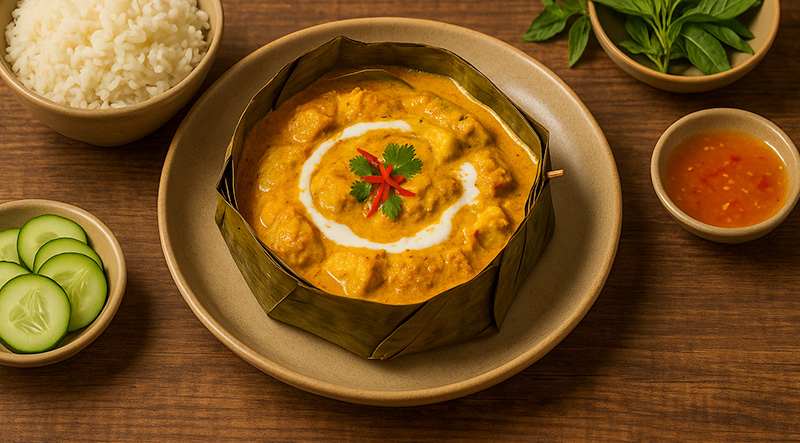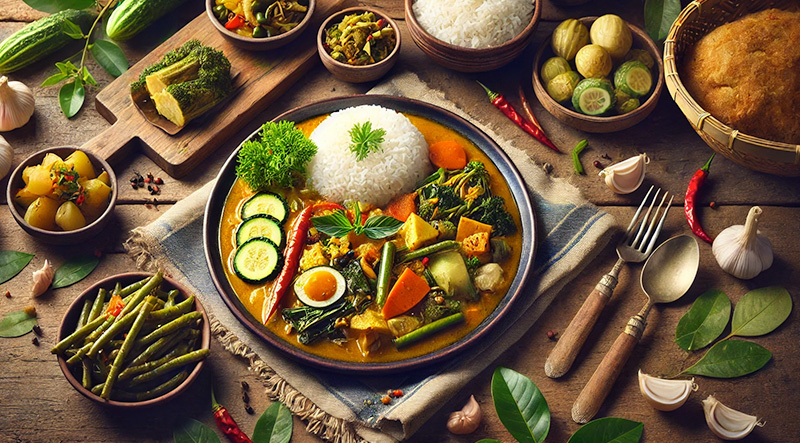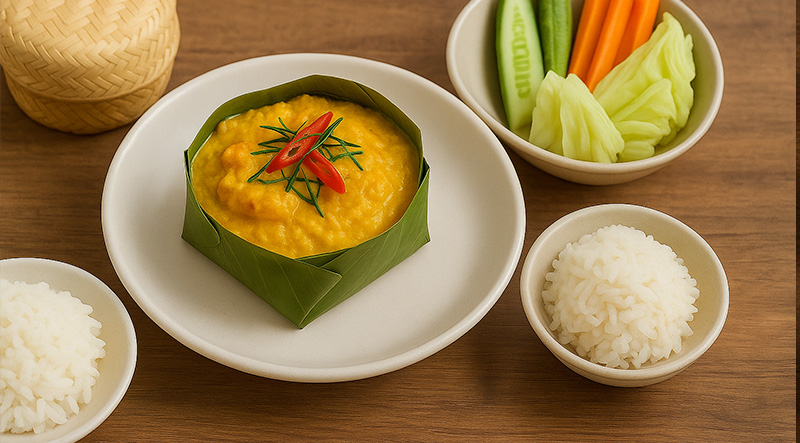Amok Trey, Cambodia’s beloved national dish, is a true feast for the senses—a silky, fragrant fish curry steamed to perfection in banana leaves. Infused with a rich blend of coconut milk, lemongrass, and kroeung (a traditional Khmer spice paste), this creamy delight melts in your mouth while delivering a gentle kick of spice and citrus. Often garnished with chili slivers and kaffir lime leaves, Amok Trey isn’t just a meal—it’s a flavorful journey into the heart of Cambodian culinary tradition. Read More...
The Rich History of Amok Trey – Cambodia’s Beloved National Dish: Amok Trey, a luscious and aromatic fish curry, is more than just Cambodia’s national dish—it’s a culinary symbol of Khmer heritage, resilience, and creativity. Its roots run deep into the heart of Cambodian history, carrying with it stories of tradition, adaptation, and cultural identity.
Origins in the Khmer Empire: Amok Trey is believed to date back to the powerful Khmer Empire (9th–15th century), when Angkor Wat stood as the crown jewel of Southeast Asia. During this era, Cambodian cuisine began to flourish, heavily influenced by the abundance of freshwater fish from the Tonlé Sap Lake and the Mekong River. These bodies of water not only shaped the livelihoods of many Cambodians but also inspired the creation of fish-based dishes like Amok Trey.
The method of steaming food in banana leaves—central to Amok Trey’s preparation—was already practiced by the Khmer people. This technique preserved moisture and allowed spices to infuse the fish with subtle layers of flavor. It also reflected a respect for nature and resourcefulness, with banana leaves serving as both a cooking vessel and a plate.
Influence of Regional Flavors: As with many dishes across Southeast Asia, Amok Trey didn’t develop in isolation. Over centuries, Cambodian cuisine absorbed influences from neighboring Thailand, Vietnam, Laos, and China. Indian and French colonial impacts also left subtle marks on the Cambodian culinary landscape. Yet Amok Trey remained uniquely Khmer—distinguished by its use of kroeung, a lemongrass-based spice paste that defines the dish’s identity.
Unlike Thai curries that often come with intense heat, Amok Trey is known for its gentle, balanced flavor. The coconut milk lends it a creamy texture, while galangal, turmeric, and kaffir lime create a deep aromatic base. This harmony of flavors speaks to the Cambodian philosophy of balance in cooking and life.
From Royal Tables to Everyday Kitchens: Traditionally, Amok Trey was a dish reserved for special occasions or royal feasts. Its careful preparation and refined flavors made it a centerpiece of ceremonial meals. Over time, however, the dish spread beyond palace walls and became a household staple, especially during national holidays and family gatherings.
Today, it is commonly served in restaurants and street food stalls alike, often presented in a decorative banana leaf cup, topped with a swirl of coconut cream and slivers of red chili. While fish—typically catfish or snakehead—remains the most common protein, modern versions may include chicken, tofu, or even shrimp, reflecting the adaptability of the dish.
A Cultural Emblem: Amok Trey is more than just food—it is a symbol of Cambodian identity and pride. For a country that has faced war, colonialism, and genocide, preserving and celebrating cultural traditions like this dish is deeply meaningful. It connects generations, tells a story of endurance, and showcases the artistry of Cambodian cuisine.
Whether enjoyed in a bustling Phnom Penh eatery or made lovingly at home, Amok Trey remains a timeless reminder of Cambodia’s flavorful past and promising future.
Make the Kroeung Paste:
Prepare the Fish Mixture:
Prepare Banana Leaf Cups (or Ramekins):

Fill the Cups:

Steam the Amok:

Serve:
Amok Trey is all about balance—don’t be afraid to adjust the sweetness, saltiness, or spice level to your taste. The fish should be tender, the texture custard-like, and the aroma intoxicating.
The total preparation and cooking time for Amok Trey is approximately 50 to 60 minutes. It takes about 20 minutes to gather and prep the ingredients, including chopping herbs, making the kroeung paste, and slicing the fish. Assembling the banana leaf cups and filling them adds another 10 minutes. The final step—steaming the filled cups—takes around 20 to 25 minutes, depending on the thickness of the mixture. This time investment yields a beautifully aromatic and traditional Cambodian dish that’s well worth the effort.
A single serving of Amok Trey, based on the provided recipe, contains approximately 350–400 calories. This estimate includes the fish, coconut milk, eggs, and aromatics, with most of the calories coming from the rich coconut milk and the fish protein. Using lean white fish and serving with a modest portion of steamed jasmine rice keeps it relatively light while still satisfying. Adding optional ingredients like peanuts or fermented fish paste may slightly increase the calorie count, but overall, Amok Trey remains a nutritious and balanced dish rich in healthy fats, protein, and traditional Southeast Asian flavors.







